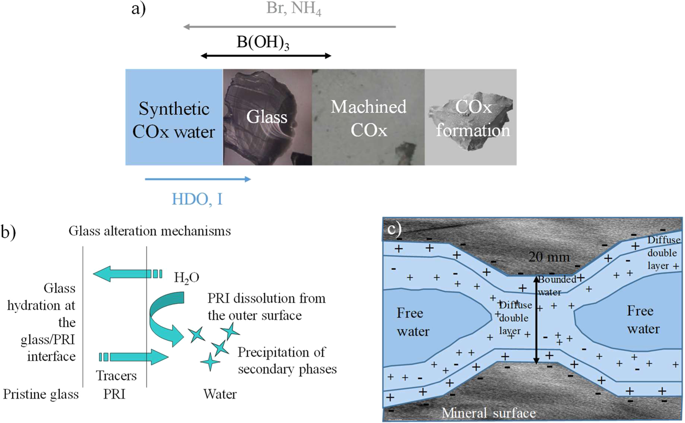npj Materials Degradation ( IF 6.6 ) Pub Date : 2019-10-31 , DOI: 10.1038/s41529-019-0100-7 Mathieu Debure , Yannick Linard , Christelle Martin , Francis Claret

|
Silicate glasses are durable materials but laboratory experiments reveal that elements that derive from their environment may induce high corrosion rates and reduce their capacity to confine high-level radioactive waste. This study investigates nuclear-glass corrosion in geological media using an in situ diffusion experiment and multi-component diffusion modelling. The model highlights that the pH imposed by the Callovo–Oxfordian (COx) claystone host rock supports secondary-phase precipitation and increases glass corrosion compared with pure water. Elements from the COx rock (mainly Mg and Fe) form secondary phases with Si provided by the glass, which delay the establishment of a passivating interface. The presence of elements (Mg and Fe) that sustain glass alteration does not prevent a significant decrease in the glass-alteration rate, mainly due to the limited species transport that drives system reactivity. These improvements in the understanding of glass corrosion in its environment provide further insights for predictive modelling over larger timescales and space.
中文翻译:

地质储藏条件下的原位核玻璃腐蚀
硅酸盐玻璃是耐用的材料,但是实验室实验表明,源自其环境的元素可能会导致高腐蚀速率,并降低其限制高放废物的能力。本研究使用原位扩散实验和多组分扩散模型研究地质介质中的核玻璃腐蚀。该模型突出表明,与纯净水相比,卡洛沃-牛津(COx)粘土岩基质岩石施加的pH值支持第二相沉淀,并增加了玻璃腐蚀。来自COx岩石的元素(主要是Mg和Fe)与玻璃提供的Si形成第二相,这会延迟钝化界面的建立。维持玻璃蚀变的元素(镁和铁)的存在并不能阻止玻璃蚀变率的显着降低,主要是由于有限的物种运输推动了系统的反应性。对周围环境中玻璃腐蚀的理解的这些改进为在更大的时间范围和空间上进行预测建模提供了进一步的见解。











































 京公网安备 11010802027423号
京公网安备 11010802027423号